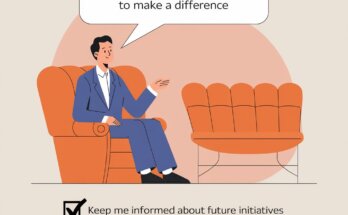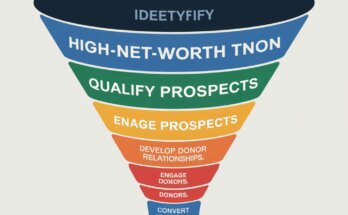Understanding The Donor Lifecycle: From Acquisition to Retention is essential for any nonprofit organization aiming to thrive in today’s competitive fundraising environment.
It’s not just about getting donations; it’s about creating a journey that transforms one-time donors into long-term supporters who are emotionally invested in your mission.
In this blog post, we’ll explore each stage of the donor lifecycle, from attracting new donors to retaining them for the long haul.
1. Donor Acquisition: The First Step in Building Relationships
The journey begins with donor acquisition. This is the process of attracting new donors to your organization. It’s a critical stage because it sets the foundation for future engagement and retention. Here are some effective strategies to help you acquire new donors:
A. Define Your Target Audience
Before you start any acquisition efforts, it’s vital to know who you’re trying to reach. Define your target audience based on demographics, interests, and values.
For example, if your nonprofit focuses on environmental conservation, your target audience might include individuals passionate about sustainability, nature lovers, and community activists.
B. Create Compelling Content
Once you’ve identified your audience, create engaging content that speaks to them. Use storytelling to illustrate the impact of your work.
For instance, the World Wildlife Fund (WWF) often shares vivid stories of endangered species and the positive outcomes of donations.
Their storytelling approach not only informs potential donors but also evokes emotions, making them more likely to contribute.
C. Leverage Social Media
In today’s digital age, social media is a powerful tool for donor acquisition. Platforms like Facebook, Instagram, and Twitter allow you to reach a vast audience quickly. Share impactful images and stories about your organization’s mission.
For example, charity: water uses social media to showcase the life-changing impact of clean water access, drawing in supporters who resonate with their cause.
D. Host Engaging Events
Events can be an excellent way to engage potential donors. Whether it’s a fundraising gala, a community picnic, or a virtual webinar, events allow you to connect with your audience personally.
For example, St. Jude Children’s Research Hospital hosts events like the annual St. Jude Walk/Run, which not only raises funds but also builds community and awareness around their mission.
2. Donor Engagement: Building Meaningful Connections
Once you’ve successfully acquired new donors, the next step is engagement. This stage is all about nurturing relationships and keeping donors connected to your organization. Here are effective strategies for engaging donors:
A. Personalize Your Communications
Personalization is key in donor engagement. Use your donors’ names in communications and reference their past contributions. This can be as simple as sending a personalized thank-you email after they donate.
Habitat for Humanity excels at this by sending personalized updates to donors, sharing how their contributions directly impact families in need.
B. Regularly Share Updates and Impact Stories
Keep your donors informed about your organization’s progress and the impact of their support. Regularly send newsletters or updates that feature success stories.
For instance, Save the Children frequently shares stories of children whose lives have been changed by donations, reinforcing the importance of ongoing support.
C. Create a Donor Community
Fostering a sense of community among your supporters can significantly enhance engagement. Consider creating a donor circle or online community where supporters can connect and share their experiences.
Pencils of Promise offers exclusive events for their donors, allowing them to meet and network with other like-minded individuals who are passionate about education.
A Story of Impact: Connecting Donors to the Cause
To illustrate the importance of engagement, let’s look at the story of Lindsay, a young professional who stumbled upon a local nonprofit focused on providing meals to the homeless. After attending an engaging fundraising event, she decided to donate $50.
Following her donation, Lindsay received a heartfelt thank-you email that included a story about a family who had been helped by the organization.
The email not only expressed gratitude, but also provided updates on how her contribution made a difference.
Encouraged by the impact she could see, Lindsay continued to follow the organization on social media and became more involved. She eventually became a regular donor, attending events and sharing her experiences with friends.
Lindsay’s journey from a first-time donor to a committed supporter demonstrates how effective engagement can transform a single contribution into a lasting relationship.
3. Donor Retention: Keeping Donors Committed
Now that you’ve engaged your donors, the focus shifts to retention. Retaining donors is critical because it is often more cost-effective than acquiring new ones.
Here are strategies to enhance donor retention:
A. Show Appreciation Regularly
Expressing gratitude should be a continuous effort, not just a one-time action. Regularly thank your donors through emails, personalized notes, or small gifts.
The Nature Conservancy often sends personalized thank-you notes that include updates on conservation projects funded by donors, making them feel appreciated and connected.
B. Offer Exclusive Benefits
Consider providing exclusive benefits for your loyal donors. This could include early access to events, insider information about your organization, or invitations to donor appreciation gatherings.
For instance, The American Red Cross offers exclusive training sessions for their top donors, allowing them to engage more deeply with the organization’s mission.
C. Gather Feedback and Adapt
Soliciting feedback from your donors shows that you value their opinions and are committed to improving your organization. Conduct surveys to understand their experiences and preferences.
The Humane Society regularly surveys its donors to gather insights on what initiatives they care about most, allowing them to tailor future campaigns accordingly.
4. Donor Reactivation: Winning Back Lapsed Donors
Despite your best efforts, some donors may become inactive over time. Reactivation is the process of reconnecting with these lapsed donors. Here’s how to do it effectively:
A. Reach Out with Personal Messages
When reaching out to lapsed donors, send personalized emails reminding them of the impact of their previous contributions.
For example, a nonprofit might send a message that highlights the difference their past donations made, such as how many meals were provided or families helped.
B. Create a Win-Back Campaign
Design a specific campaign aimed at re-engaging lapsed donors. Consider offering incentives like matching donations or exclusive gifts for those who return.
For instance, Feeding America launched a campaign offering to double all donations made by lapsed donors, reigniting their interest and encouraging them to contribute again.
C. Share New Developments
If your organization has achieved significant milestones or launched new initiatives, make sure to communicate these changes to lapsed donors. This can reignite their interest and show them that your organization is evolving.
For example, a nonprofit that recently expanded its services or reached a major fundraising goal can send an update to lapsed donors, inviting them to be part of the continued journey.
5. Donor Upgrades: Encouraging Increased Contributions
Another important aspect of the donor lifecycle is upgrading donors. This involves encouraging existing donors to increase their contributions. Here are some effective strategies:
A. Showcase the Impact of Increased Donations
Demonstrate how larger donations can lead to greater impact. Use visual aids, such as infographics or videos, to illustrate the difference an increased donation can make.
For example, an organization might create a visual showing how $100 can provide food for a family for a month, while $500 can support an entire community outreach program.
B. Implement Monthly Giving Options
Encouraging donors to switch to a monthly giving model can help them budget their contributions while providing your organization with a steady income stream.
The American Heart Association offers a monthly giving program that allows donors to contribute smaller amounts consistently, making it easier for them to give more over time.
C. Provide Exclusive Opportunities for Upgraded Donors
Offer exclusive access to events, reports, or experiences for donors who increase their contributions.
For example, Make-A-Wish Foundation invites upgraded donors to special donor recognition events, allowing them to meet wish recipients and witness the impact of their contributions firsthand.
The Ongoing Journey of Donor Relationships
In summary, understanding The Donor Lifecycle: From Acquisition to Retention is essential for building and maintaining strong relationships with your supporters.
As you implement these strategies, remember that donor relationships are not transactional; they require genuine care and effort. By treating your donors as valued partners, you can nurture their loyalty and commitment to your cause.
If you found this post helpful and want to stay updated with more expert tips and resources, subscribe to the Nonprofit Navigators Newsletter! By joining our community, you’ll gain access to job opportunities, grant opportunities, exclusive webinars, events, and so much more.
>>>>Additional Resources>>>>>
- The Small Business’s Guide to Winning Grants
- Request for Proposal Success: How to Write Proposals That Win
- The Ultimate Guide to Federal Grant Applications: Techniques for Success
- Digital Marketing for Nonprofits: A Comprehensive Guide to Boosting Your Impact Online
- Mastering Online Fundraising: A Nonprofit’s Guide to Digital Success




